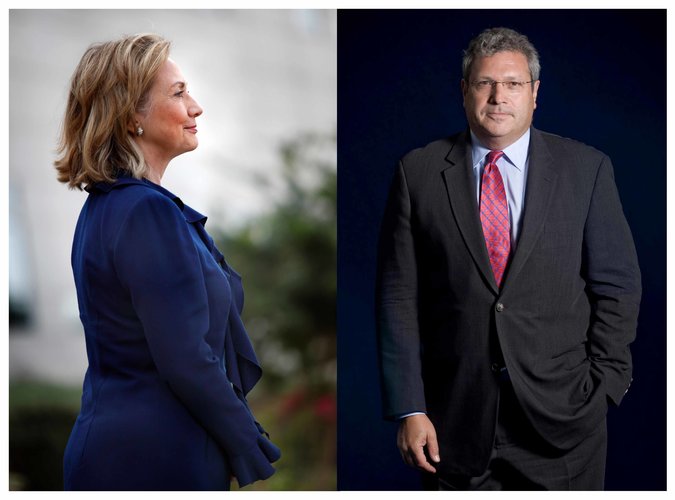
Jacob Heilbrunn
Jacob Heilbrunn is the editor of the National Interest and the author of “They Knew They Were Right: The Rise of the Neocons.”
Are Neocons Getting Ready to Ally With Hillary Clinton?
WASHINGTON — AFTER nearly a decade in the political wilderness, the neoconservative movement is back, using the turmoil in Iraq and Ukraine to claim that it is President Obama, not the movement’s interventionist foreign policy that dominated early George W. Bush-era Washington, that bears responsibility for the current round of global crises.
Even as they castigate Mr. Obama, the neocons may be preparing a more brazen feat: aligning themselves with Hillary Rodham Clinton and her nascent presidential campaign, in a bid to return to the driver’s seat of American foreign policy.
To be sure, the careers and reputations of the older generation of neocons — Paul D. Wolfowitz, L. Paul Bremer III, Douglas J. Feith, Richard N. Perle — are permanently buried in the sands of Iraq. And not all of them are eager to switch parties: In April, William Kristol, the editor of The Weekly Standard, said that as president Mrs. Clinton would "be a dutiful chaperone of further American decline.”
But others appear to envisage a different direction — one that might allow them to restore the neocon brand, at a time when their erstwhile home in the Republican Party is turning away from its traditional interventionist foreign policy.
It’s not as outlandish as it may sound. Consider the historian Robert Kagan, the author of a recent, roundly praised article in The New Republic that amounted to a neo-neocon manifesto. He has not only avoided the vitriolic tone that has afflicted some of his intellectual brethren but also co-founded an influential bipartisan advisory group during Mrs. Clinton’s time at the State Department.
Mr. Kagan has also been careful to avoid landing at standard-issue neocon think tanks like the American Enterprise Institute; instead, he’s a senior fellow at the Brookings Institution, that citadel of liberalism headed by Strobe Talbott, who was deputy secretary of state under President Bill Clinton and is considered a strong candidate to become secretary of state in a new Democratic administration. (Mr. Talbott called the Kagan article "magisterial,” in what amounts to a public baptism into the liberal establishment.)
Perhaps most significantly, Mr. Kagan and others have insisted on maintaining the link between modern neoconservatism and its roots in muscular Cold War liberalism. Among other things, he has frequently praised Harry S. Truman’s secretary of state, Dean Acheson, drawing a line from him straight to the neocons’ favorite president: "It was not Eisenhower or Kennedy or Nixon but Reagan whose policies most resembled those of Acheson and Truman.”
Other neocons have followed Mr. Kagan’s careful centrism and respect for Mrs. Clinton. Max Boot, a senior fellow at the Council on Foreign Relations,noted in The New Republic this year that "it is clear that in administration councils she was a principled voice for a strong stand on controversial issues, whether supporting the Afghan surge or the intervention in Libya.”
And the thing is, these neocons have a point. Mrs. Clinton voted for the Iraq war; supported sending arms to Syrian rebels; likened Russia’s president, Vladimir V. Putin, to Adolf Hitler; wholeheartedly backs Israel; and stresses the importance of promoting democracy.
It’s easy to imagine Mrs. Clinton’s making room for the neocons in her administration. No one could charge her with being weak on national security with the likes of Robert Kagan on board.
Of course, the neocons’ latest change in tack is not just about intellectual affinity. Their longtime home, the Republican Party, where presidents and candidates from Reagan to Senator John McCain of Arizona supported large militaries and aggressive foreign policies, may well nominate for president Senator Rand Paul of Kentucky, who has been beating an ever louder drum against American involvement abroad.
In response, Mark Salter, a former chief of staff to Senator McCain and a neocon fellow traveler, said that in the event of a Paul nomination, "Republican voters seriously concerned with national security would have no responsible recourse” but to support Mrs. Clinton for the presidency.
Still, Democratic liberal hawks, let alone the left, would have to swallow hard to accept any neocon conversion. Mrs. Clinton herself is already under fire for her foreign-policy views — the journalist Glenn Greenwald, among others, has condemned her as "like a neocon, practically.” And humanitarian interventionists like Samantha Power, the ambassador to the United Nations, who opposed the second Iraq war, recoil at the militaristic unilateralism of the neocons and their inveterate hostility to international institutions like the World Court.
But others in Mrs. Clinton’s orbit, like Michael A. McFaul, the former ambassador to Russia and now a senior fellow at the Hoover Institution, a neocon haven at Stanford, are much more in line with thinkers like Mr. Kagan and Mr. Boot, especially when it comes to issues like promoting democracy and opposing Iran.
Far from ending, then, the neocon odyssey is about to continue. In 1972, Robert L. Bartley, the editorial page editor of The Wall Street Journal and a man who championed the early neocon stalwarts, shrewdly diagnosed the movement as representing "something of a swing group between the two major parties.” Despite the partisan battles of the early 2000s, it is remarkable how very little has changed.



_jpg/250px-ElbeDay1945_(NARA_ww2-121).jpg)





